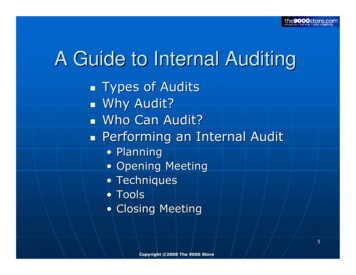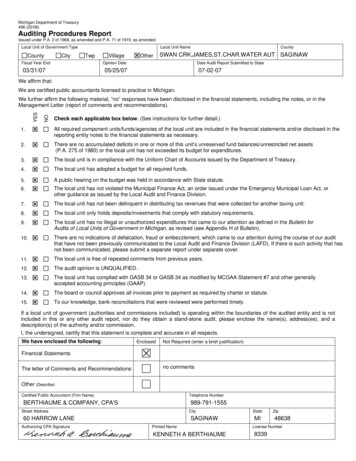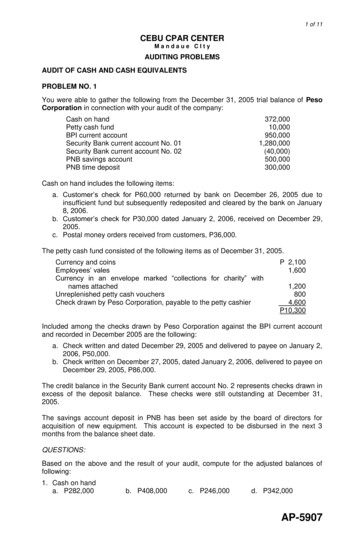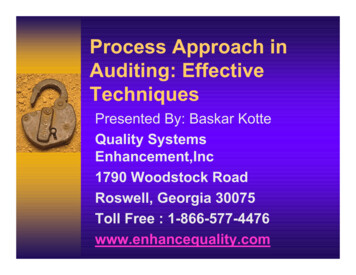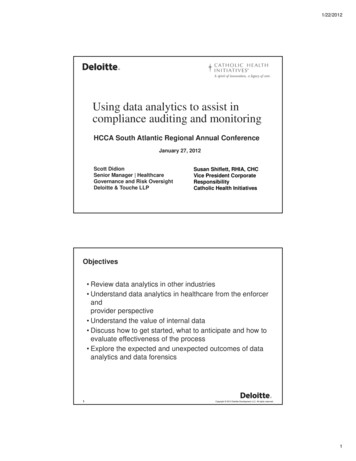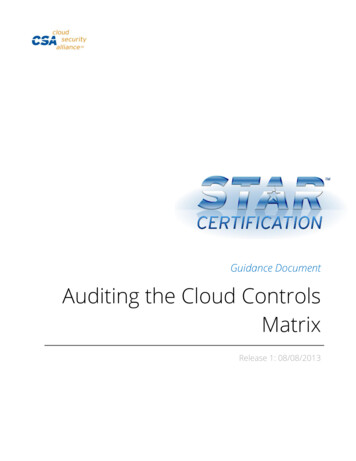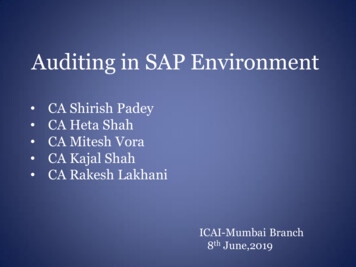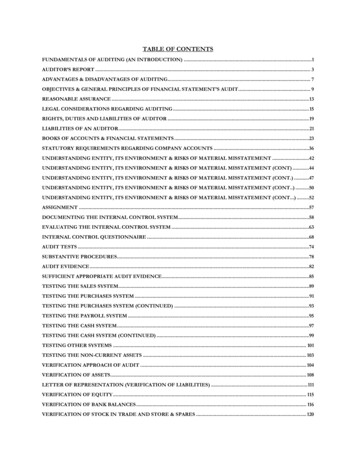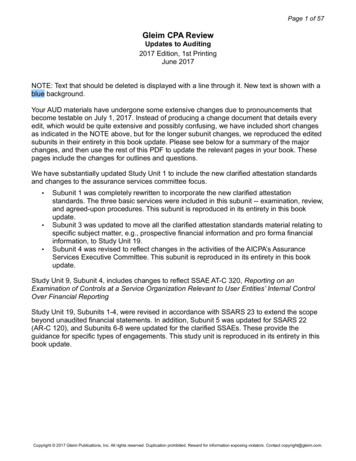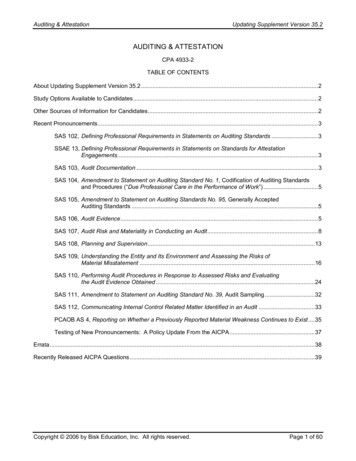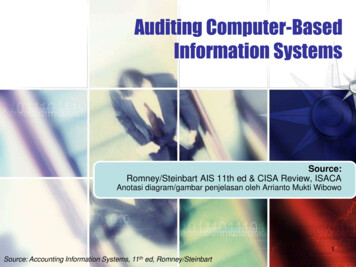
Transcription
A Guide toProject AuditingAssociation for Project Management34641 00 FM to End-landscape.indd 113/04/2018 14:42
Contents1Introduction1.1 Introduction1.2 Purpose of the guide1.3 Structure of the guide1.4 What is project auditing?1.5 Principles of project audit1.6 Project life cycle1.7 Why do we need project audits?1.8 Who should use the guide?1.8.1 The project sponsor1.8.2 The project team1.8.3 The project auditor2Project audit process2.1 Planning the audit2.1.1 Audit prioritisation2.1.2 Choosing the audit team2.1.3 Information gathering2.1.4 Risk assessing a project2.1.5 The project audit programme2.2 Fieldwork2.2.1 Elements for review2.3 Evaluation and reporting2.3.1 Evaluation2.3.2 Reporting2.4 Follow-up2.5 Benefits evaluation2.6 Legacy and lessons learned11223344555678888991010111112131313Appendix 1Matrix of element-based areas of review, risks and controls1414Appendix 2Comparison of project audit elements for review, withassurance measures toolkit categories3131iii34641 00 FM to End-landscape.indd 313/04/2018 14:42
1Introduction1.1 IntroductionProject assurance is a fundamental part of effective project governance. Theproject audit is the means to provide that assurance and enables the sponsor tohave confidence that the governance is working and that the project is beingmanaged as intended. There is currently a considerable amount of informationrelating to the assurance of projects and programmes, and why it is important.This guide seeks to demonstrate how to plan and undertake a comprehensiveaudit of a project, thereby providing that assurance.The guide seeks to explain the role of an audit, how it could be planned andundertaken, the degrees of assurance that can be given, and how project auditscan be aligned to organisational governance. Although the guide acknowledgesthe need for project audits to be integrated with the works of other assuranceproviders (particularly technical and quality audits) a project audit is a stand-aloneprocess aimed at the three main roles involved in a project.The three main roles involved in project audits are:RoleDescriptionOrganisation board/audit committee/sponsor/other stakeholdersThose who schedule the project audit andreceive the audit findingsProject teamThose whose project is being audited, withwhom the auditors interactProject auditor(s)Those who undertake the audit, and report itsfindings and make recommendationsFor any audit to be successful and provide value to all parties, these threemain roles must work together and understand each other’s function in theprocess.As is common in all projects it is vital that there is a recognition that peopleundertaking different project roles may have differing interests and perceptionsabout project outputs, progress and the various stakeholders. This guide therefore134641 00 FM to End-landscape.indd 113/04/2018 14:42
A Guide to Project Auditingrefers to how audits relate to the various responsibilities within a project and howto apply the processes associated with auditing in a project context taking projectresponsibilities into consideration. These processes include: the development ofan annual audit plan; choosing the auditor/audit team to undertake the work;developing an audit programme; performing, closing, and reporting the audit;and undertaking follow-ups.1.2 Purpose of the guideThis guide is principally intended for use by project auditors in developing anaudit approach to the review and assurance of projects. However, it is alsointended to be of value to anyone involved in the management and administrationof projects, as it records areas of project risk, and identifies audit evidence andpractices. The guide will also indicate those aspects of a project which theauditors may choose to review, and how the audit will be performed.This guide is not intended to provide step-by-step instructions on how to carryout audits on any particular type of project; rather, it will provide guidance whichcan be adapted by the user to the circumstances of their own projects. The auditcan then be planned, performed and reported on, and based on the auditor’spreferred approach, adapted to suit the particular project discipline.In section 2.2.1, and expanded in Appendix 1, the guide proposes someelements and areas of interest for review by project auditors, together with therisks and expected controls to manage those risks. These elements do not forman exhaustive list so it is recommended that further assessment by the projectauditor is always necessary to decide upon areas of focus before a project audit isundertaken.1.3 Structure of the guideThe guide focuses on the various aspects of project audits, to answer the followingthree questions:nnnWhat is an audit? (And how an audit differs from other assurance methods.)Why do we undertake project audits?How should a project audit be planned, performed, evaluated,reported, and followed up?234641 00 FM to End-landscape.indd 213/04/2018 14:42
IntroductionThis guide covers the planning of project audits (Section 2.1); suggested elementsof a project which are to be reviewed (Section 2.2.1 and Appendix 1); evaluationand reporting (Section 2.3); and follow-up processes (Section 2.4).1.4 What is project auditing?Auditing is defined by the Chartered Institute of Internal Auditors as ‘anindependent, objective assurance and consulting activity designed to add valueand improve an organisation’s operations. It helps an organisation accomplish itsobjectives by bringing a systematic, disciplined approach to evaluate and improvethe effectiveness of risk management, control, and governance processes’.In any audit, the auditor(s) perceives and recognises the propositions beforethem for examination, collects evidence, evaluates the same, and on this basisformulates an opinion on the adequacy of controls within the activity being audited.Throughout this guide we use the term ‘project’ to mean ‘a unique, transientendeavour undertaken to achieve planned objectives’ (see APM Body ofKnowledge, 6th edition); the audit of programmes and portfolios will requiredifferent techniques. Auditing of a project should be seen in the context of thedefinition of project, programme and portfolio (P3) assurance set out in the APMBody of Knowledge: P3 Assurance is ‘the process of providing confidence tostakeholders that projects, programmes and portfolios will achieve their scope,time, cost and quality objectives, and realise their benefits’.1.5 Principles of project auditThe APM publication A Guide to Integrated Assurance identifies the principlesgoverning project audit, which are those established for the provision ofassurance generally. Project audit should be:nnnnnnindependent, and supported in this by the organisation board;accountable within a governance and reporting system;planned and coordinated as part of the organisation’s management system;proportionate to risk potential and the assurance needs of stakeholders;risk-based, against an independent risk evaluation;able to allow the impact of identified weaknesses to be reported and addressed,by follow-up and escalation.334641 00 FM to End-landscape.indd 313/04/2018 14:42
1534641 00 FM to End-landscape.indd 1513/04/2018 14:42Review of approved business case toidentify responsibilities and ensure thatbusiness case template and guidance isavailableReview of approved business case toassess extent of complianceReview of cost methodology andprocesses based on approved businesscaseReview of approved business case. Ensurethat cost of risk has been accounted forSenior responsible owner/sponsoridentified with appropriate authority todeliver project outcomesRequirement that business cases takeaccount of approved modelCosts (including life cycle costs) havebeen reliably estimated and a mechanismexists for these to be refinedDue account is taken of optimism bias inrespect of costThe business case is not robust, or doesnot exist or outputs and outcomes are notmeasurableBusiness case does not fit withorganisation’s model e.g. five case model:strategic, economic, commercial, financialand management casesProject cost as stated is not definedeffectively or is insufficient to allowdeliveryIf already funded: Level of agreed fundingis insufficient to deliver objectivesReview whether additional funding shouldbe sought to enable successful deliverySchedule of delegated authorityReview of stage gate (gateway) approvalsReview of appropriate board minutes anddocumentationBusiness caseFormal approval of project start-uprecorded and confirmation that it alignswith strategic objectivesThe programme/project is not alignedwith organisation or business strategyAudit methods includeBusiness planalignmentControlRiskArea of reviewElement 1. Project definition and requirements management: clear and controlled baseline requirements, objectives, successcriteria, business case, terms of reference, contracts and benefits realisation
1634641 00 FM to End-landscape.indd 1613/04/2018 14:42Target dates have been subject to a realitycheck and a mechanism exists for thesedates to be refinedTarget dates are unrealistic or overlyambitiousAuthorisationincluding definitionof baselineThe project has commenced prior toformal authorisationThe project’s scope/plan is not baselinedat time of project startRequirementsdefinition – clear/complete/understood?Required outcomesclear/agreedProject scope definedThe project scope/requirements is notclearly defined or understoodScope definedincluding changecontrol processesProject governance arrangements reflectorganisation requirementsProject plan developed to appropriatelevelProject manager’s responsibilities andlimits of authority definedChange control processes implementedApproved business case is used as achange control baseline document, and issubject to periodic reviewDue account is taken of optimism bias inrespect of target dates and schedulesControlRiskBusiness cases are not used as a controlagainst achievement of the projectdeliverablesArea of reviewReview of project governancearrangements including authorisation tostart projectsReview of PID and approved businesscase to ensure clarity of scope andplanningSchedule of delegation in PID orapproved business caseAssessment of change control processesReview of approved business case –scope must be clear and unambiguousAssessment of change controlmechanisms applicable to project and thatbusiness case is routinely updatedReview of approved business caseReview of schedule and programmemethodology and processesAudit methods include
1.6 Project life cycle 4 1.7 Why do we need project audits? 4 1.8 Who should use the guide? 5 1.8.1 The project sponsor 5 1.8.2 The project team 5 1.8.3 The project auditor 6 2 Project audit process 7 2.1 Planning the audit 8 2.1.1 Audit prioritisation 8 2.1.2 Choosing the audit team 8 2.1.3 Information gathering 8 2.1.4 Risk assessing a project 9 2.1.5 The project audit programme 9 2.2 .
